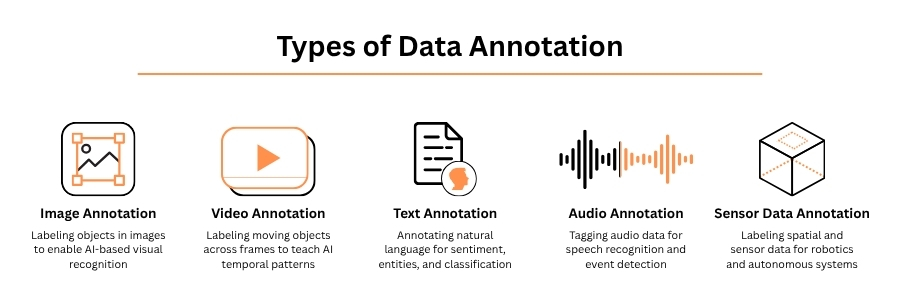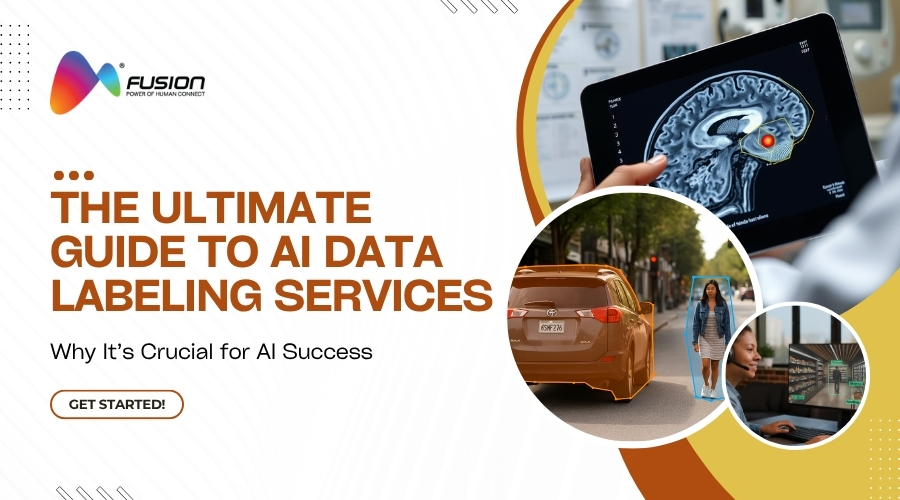In the rapidly evolving world of Artificial Intelligence (AI) and Machine Learning (ML), raw data is abundant—but its true value remains dormant without one essential process: AI data labeling services. It’s the quiet powerhouse enabling AI to understand the world, make predictions, and deliver transformative outcomes.
While often underappreciated, AI data labeling services are the foundation of every successful AI application, from autonomous vehicles to voice assistants. In this guide, we explore what they are, why they’re critical, and how they drive AI innovation forward.
What Are AI Data Labeling Services?
AI Data Labeling Services, also known as data annotation or data tagging, involve tagging, categorizing, transcribing, or segmenting raw data so that it can be understood and utilized by machine learning models. This may involve labeling objects in an image, identifying sentiment in a sentence, or transcribing audio to text.
To train an AI model to recognize something—say, a cat—you can’t just provide random images. You must show labeled examples: “This is a cat,” “This is not a cat.” These labels serve as a reference during training, helping the model learn the patterns associated with each class or concept.
Labeling transforms unstructured data—such as images, videos, audio, and text—into structured, machine-readable data. It enables algorithms to identify patterns, make informed decisions, and execute specific tasks efficiently.
AI without annotated data is like a rocket without fuel—immense potential, but no lift-off.
The Market Opportunity
The global data annotation market is projected to grow at a compound annual growth rate of over 26%, reaching $5.33 billion by 2030. As industries accelerate their adoption of AI, demand for scalable and precise annotation continues to surge.
Why AI Data Labeling Services Are Crucial for AI Success
Labeling is not merely a preliminary step; it is the bedrock of AI development. Without it, even the most advanced algorithms can’t learn effectively. Here’s why:
Training Machine Learning Models
Supervised learning, which powers many AI systems, relies on labeled data to identify features and patterns. The performance of these models is directly proportional to the quality of the data on which they are trained.
Tailored for Specific Tasks
Every AI use case requires different types of annotation. For instance, a self-driving car needs labeled images and sensor data, while a chatbot needs labeled conversational text. The right approach ensures relevance and accuracy.
Reducing Bias and Ensuring Fairness
Bias in training data can lead to biased AI outcomes. Labeling efforts that are diverse and representative help build fairer systems that don’t marginalize specific groups.
Enabling Continuous Learning
AI models require regular retraining to stay effective. Labeled data enables teams to update and refine models over time, particularly as new use cases or data sets emerge.
Validating and Testing Models
Labeled data serves as a “ground truth” benchmark to evaluate model accuracy. It helps identify errors, measure precision, and improve reliability.
Your AI is only as good as the data it learns from. Garbage in, garbage out—accurate annotation makes the difference.
Types of Data Annotation and Techniques
Different AI applications require different annotation methods. Below are the key types and techniques used across industries:

Image Annotation
Image data annotation involves labeling digital images to train AI models to recognize, classify, and interpret visual information. This process is essential in industries such as healthcare, agriculture, automotive, retail, and security, where machine learning systems rely on accurate visual understanding to make decisions. Whether it’s detecting diseases in medical scans or enabling facial recognition systems, image annotation provides the structured data that allows machines to ‘see’ the world the way humans do.
Image data is foundational in computer vision tasks. Techniques include:
- Bounding Boxes: Drawing rectangles around objects for detection (e.g., identifying pedestrians).
- Polygons: Labeling irregular shapes for precise segmentation (e.g., buildings in aerial photos).
- Keypoint Annotation: Marking facial landmarks or human joints for pose estimation.
- Semantic Segmentation: Labeling each pixel in an image for object class identification.
- Instance Segmentation: Differentiating between individual instances of the same class.
- Lines and Splines: Labeling roads or lanes for autonomous driving.
- Image Classification: Assigning an overall label to an image (e.g., ‘cat’, ‘dog’).
Video Annotation
Video annotation involves labeling moving images frame by frame to capture dynamic events, actions, and interactions over time. It plays a vital role in domains where temporal context is essential—such as autonomous vehicles, sports analytics, robotics, and surveillance. Unlike static image annotation, video annotation considers movement, continuity, and changes in object appearance or position over time. This added complexity enables AI models to interpret motion, track behaviors, and respond in real-time.
Video annotation includes labeling moving objects across frames and recognizing activities.
- Object Tracking: Following an object through multiple frames to understand motion.
- Activity Recognition: Detecting actions or behaviors (e.g., walking, waving, falling).
Text Annotation (Natural Language Processing)
Text annotation is fundamental to enabling machines to comprehend and generate human language. It involves identifying and labeling elements within textual data so that Natural Language Processing (NLP) models can learn language patterns, extract insights, and understand context. NLP-based applications are everywhere—from smart assistants and translation apps to fraud detection and legal document review. The richness and accuracy of text annotations directly influence the language understanding capabilities of AI systems. For tasks involving language understanding, annotation may include:
- Named Entity Recognition (NER): Identifying proper nouns like names and organizations.
- Sentiment Analysis: Determining if text is positive, negative, or neutral.
- Text Classification: Grouping text into categories (e.g., spam vs. not spam).
- Part-of-Speech Tagging: Identifying grammatical functions (noun, verb, adjective).
- Relationship Extraction: Linking entities (e.g., “John works at Google”).
- Linguistic Annotation: Annotating syntax, semantics, and discourse elements.
Audio Annotation
Audio annotation is essential for enabling machines to understand and interpret sound. It involves tagging and categorizing audio signals — encompassing spoken language, background noise, and specific sound events — to train systems in speech recognition, voice command processing, acoustic scene analysis, and other related applications. This is particularly critical for applications like voice assistants, call center analytics, accessibility tools, and security systems. Annotated audio data helps AI distinguish between speakers, identify accents, detect emotional tone, and respond appropriately to verbal cues.
Used in speech recognition, voice interfaces, and sound classification.
- Transcription: Converting spoken language into written text.
- Speaker Diarization: Identifying who spoke when in a conversation.
- Sound Event Detection: Tagging specific audio events like sirens or alarms.
Sensor Data Annotation (LiDAR, Radar, etc.)
Sensor data annotation involves labeling information captured by advanced sensors such as LiDAR, radar, and depth cameras. This type of annotation is indispensable for machine perception in autonomous systems, where spatial understanding is key. It enables AI models to interpret real-world environments in 3D space, detecting objects, estimating distances, and navigating safely. Sensor annotations are particularly relevant in sectors such as autonomous driving, robotics, drone navigation, and industrial automation, where combining data from multiple sensor modalities is crucial for precision and reliability. Critical for autonomous vehicles and robotics.
- 3D Bounding Boxes: Encapsulating objects within three-dimensional point clouds.
- Point Cloud Segmentation: Classifying each point in a 3D environment.
- Sensor Fusion Annotation: Combining visual and spatial data for holistic understanding.
Who Performs AI Data Labeling Services?
Data annotation can be carried out in several ways:
- Human Annotators: Essential for complex or subjective tasks such as emotion recognition.
- Crowdsourcing: Platforms like Amazon Mechanical Turk enable distributed labeling, but the quality can vary.
- In-House Teams: Offer higher consistency and control, especially for sensitive data.
- Automated Tools: Utilize AI to assist with annotation, although human review remains necessary for accuracy.
- Specialized Vendors: Provide domain-specific annotation services with trained professionals and QA processes.
Fusion CX delivers high-quality data annotation services across various industries, including healthcare, retail, automotive, and finance, by combining human expertise with proprietary technologies such as Arya (AI agent assist), AI QMS (quality management system), and MindSpeech (voice harmonization).
Fusion CX supports a range of annotation needs—from pixel-perfect medical image labeling to complex multilingual text classification and 3D sensor fusion annotation for autonomous systems. With delivery centers worldwide and dedicated vertical teams, Fusion CX ensures that projects are not only accurate and scalable but also compliant with data privacy and industry regulations.
Whether it’s annotating radiology scans, training sentiment models, or labeling LiDAR datasets, Fusion CX enables faster model deployment, increased AI accuracy, and continuous model optimization through its structured QA workflows and retraining pipelines. As a trusted provider of data annotation services, Fusion CX helps clients build smarter, safer, and more responsible AI products.
Best Practices for AI Data Labeling Services
To ensure high-quality outcomes, organizations should:
- Define precise objectives and use case requirements.
- Create annotation guidelines and training materials for consistency.
- Utilize multiple annotators and assess inter-annotator agreement to enhance accuracy.
- Regularly audit and refine annotations for quality assurance.
- Utilize annotation tools that incorporate version control, automation, and built-in QA features.
Companies that outsource to partners specializing in data annotation services often gain access to pre-built workflows, domain-specific expertise, and cost efficiencies that internal teams may lack.
Real-World Impact of High-Quality Annotation
Well-annotated data has a far-reaching impact:
- In healthcare, labeled radiology images facilitate the training of AI models for disease diagnosis, achieving accuracy rates comparable to those of expert physicians.
- In retail, annotated customer reviews support sentiment analysis, allowing brands to adjust offerings in real-time.
- In transportation, labeled LiDAR and camera data allow autonomous vehicles to navigate roads safely.
The annotated data used in these applications is not a one-time task—it is ongoing, iterative, and must evolve in tandem with the model and the environment in which it operates.
Conclusion: AI Data Labeling Services Are the Lifeline of AI
While it may not make headlines, data annotation plays a central role in AI’s success. It’s the bridge between raw data and smart machines. Without it, AI models cannot learn, adapt, or perform reliably.
In a world increasingly driven by data, annotation is not just a technical necessity—it’s a strategic advantage. Companies that prioritize well-structured, bias-free, high-quality annotated data will lead the next wave of AI innovation.
Machines can’t learn what they can’t see. Data annotation is how we show them the world.
For organizations building AI products, investing in thoughtful, expert-driven annotation is one of the smartest decisions they can make. As the saying goes in the AI world: “Better labels, better models.”
Ready to transform your raw data into AI-ready intelligence?
Partner with Fusion CX for scalable, precise, and industry-specific data annotation solutions.
Get in touch with our team today to discuss your use case — or explore how our AI-enhanced annotation workflows can accelerate your model’s performance.

